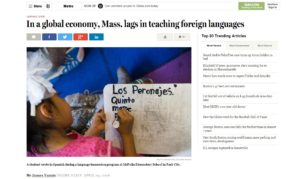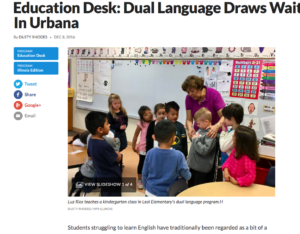
Increasingly popular dual-language programs don’t just benefit white, English-speaking students – but education reporters tend to cover them that way.
By Tara García Mathewson
When Boston Globe education reporter James Vaznis thinks about dual-language education, he frames the benefits through the prism of his own life story.
“I’m someone who wishes I was able to speak a second language,” Vaznis said in a recent interview. “I don’t.” He took two years of Spanish in high school and tried again in college, but he never became fluent in a second language.
“I wish when I was young I had the opportunity to go to a dual-language school and had learned it along the way,” said Vaznis. “When you’re younger you pick it up a lot more quickly.”
Through this lens, Vaznis wrote a comprehensive piece last April comparing widespread dual-language education offerings in Utah with limited opportunity in Massachusetts.
After flying from Boston to Park City and interviewing teachers, administrators, parents and students involved in the program, Vaznis wrote a thorough, 1,800-word story.
Yet only two sentences – 59 words – focus on the academic benefits to English learners:
Dual-language schools could also address another huge problem in Massachusetts: a stubborn achievement gap between native-English speakers and immigrant students, who tend to have among the lowest standardized test scores and high school graduation rates.
A separate body of research has shown that English-language learners in dual-language programs tend to achieve at higher rates than those in segregated programs.
The story includes no discussion of the cultural value for these students, who come to school speaking a language other than English and are most often seen for what they lack – English fluency.
In contrast, dual-language programs conceive of these students as having an advantage. They are “emerging bilinguals.”

April 2016 Boston Globe story compared dual-language offerings in Utah to Massachusetts.
Dual-language programs generally give students the opportunity to learn academic content in two languages starting in kindergarten, with a goal of making students bilingual and biliterate by middle school. They are increasingly popular among families from all cultures.
Education reporters have caught onto the trend, but – perhaps not surprisingly – the most common angle for stories about dual-language initiatives reflects the lack of diversity among education journalists and glosses over the benefits of these programs for students learning English.
David Nieto, executive director of the BUENO Center for Multicultural Education at the University of Colorado at Boulder, does not complain about any attention on a program he finds vital.
However, he will admit he finds most coverage of dual-language education to be superficial.
“Most of what I’ve read focuses on the benefit to white, middle class families,” he said in a recent interview.
For Nieto the value of Spanish-English dual-language education for the fast-growing Latino population in U.S. schools is front-and-center. Yet in many regions, journalists find it more palatable to highlight the stories of white students rather than their peers who either are or are the children of immigrants.
Dusty Rhodes an education reporter for the NPR station in Springfield, Illinois, started off the print version of a story that aired in December like this:
Students struggling to learn English have traditionally been regarded as a bit of a challenge in your standard public school. But in Urbana, these kids are valued for their ability to help their English-speaking peers learn a second language.
In an interview, Rhodes said she was writing for an audience she saw as hostile toward immigrants and resentful of the cost of educating their children. To her, the dual-language program was a strong example of why these students should be embraced. Yet her framing values native Spanish-speakers solely for their role in improving the education of their English-speaking peers.
Rhodes said that wasn’t her goal. She was trying to make a relatively lengthy story interesting.
“It’s like a trick you play on people,” Rhodes said. “It’s like you think it’s this problem, you tell them what they want to hear and then you flip it on them kind of. I was just trying to get people to re-think how they regard these children.”
Still, Rhodes’ story incorporates the perspective of Spanish speakers enrolled in the Illinois program as secondary. And she’s not alone – perhaps for a predictable reason. A 2015 national survey of education journalists found 78 percent were white. Like every other ethnic group, white journalists will naturally recognize the benefits of programs like dual-language education for students who are most like them. That certainly contributes to the routine holes in coverage of these programs.

NPR Illinois dual-language story.
As a member of the minority in education journalism – part of the 22% who are nonwhite and the unknown fraction who are bilingual – I try to fill some of those gaps. But the fact is, I, too approach the stories through a prism of my own experiences.
When I think about the value of dual-language education I think about students like me, only these students are ones who, through dual-language education, get the opportunity to preserve a heritage language generations after their families migrate here. Or I think about students like my mom, who grew up speaking Spanish but never took a class in it. These students get a chance at academic proficiency that will set them up to not only speak but also read and write in two languages.
It is not surprising that Vaznis, Rhodes, and I each write about dual-language education differently. The problem is, Vaznis and Rhodes are part of the vast majority of education journalists – white and monolingual – whose perspectives unduly shape mainstream coverage.
In 2016 stories appeared about dual-language in regional papers like the Marietta Daily Journal, education-only outfits like Chalkbeat and administrator-focused publications like District Administration – all outlining the demand for dual-language and focusing more heavily on the special significance of such an opportunity for native English-speakers.
To their credit, Chalkbeat and The Hechinger Report have both published stories that expanded the narrative, focusing instead on the value of dual-language education for native Spanish-speakers and the equity issues inherent in ignoring them. (Full disclosure: I wrote the Hechinger story.)
Case studies of Spanish-English dual-language programs have shown that highlighting the value of Latino culture and language can make native Spanish-speakers more confident and better engaged in school. Dual-language programs are also the only ones that have been shown to eliminate the achievement gap between English learners and their peers. School District U-46, west of Chicago, and the Austin Independent School District, in Texas, have expanded their dual-language programs districtwide specifically to give native Spanish-speakers a way to learn a second language without losing their first.
White, monolingual reporters may not instinctively gravitate toward these stories, but as the majority group in education journalism today, they should find more ways to tell them, too.
Tara García Mathewson is a Boston-based freelance education writer whose work has appeared in The Huffington Post, The Christian Science Monitor, The Hechinger Report, National Catholic Reporter and Education Dive, among others. You can find her at http://www.taragm.com and @TaraGarciaM on Twitter.
Previous columns:
Education Journalism’s Diversity Challenge













